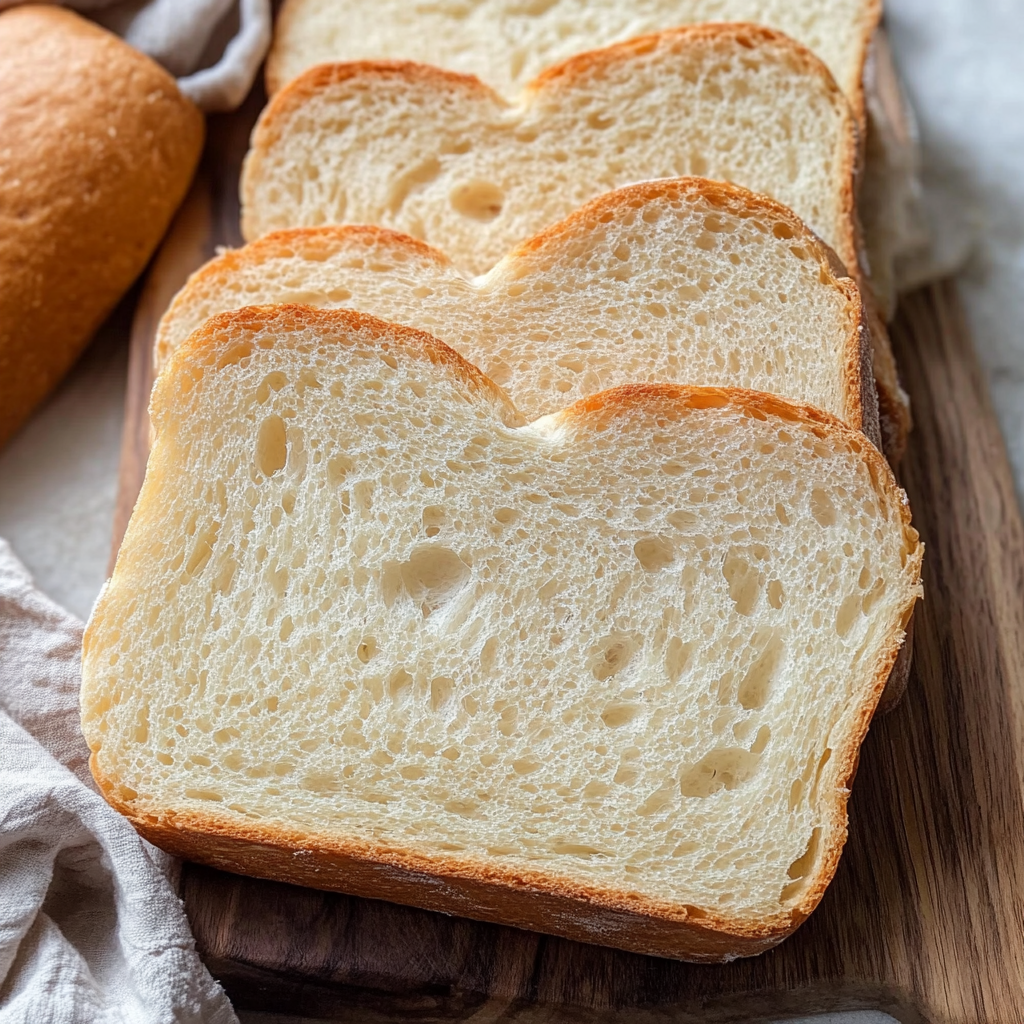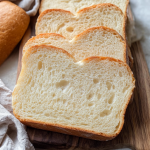Advertisement
The Ultimate Sourdough Sandwich Bread Recipe: Soft, Fluffy, and Perfect for Sandwiches
If you’re looking for a delicious, easy-to-make sourdough sandwich bread that’s soft, fluffy, and has just the right amount of tang, you’ve come to the right place! This sourdough discard sandwich bread recipe is a game-changer—using your sourdough discard to create a loaf that’s perfect for sandwiches, toast, or just enjoying with butter.
Unlike traditional sourdough bread that requires a long fermentation process, this recipe takes just a few hours from start to finish. The result? A tender crumb, soft crust, and that classic sourdough flavor without the wait.
Let’s dive into the best sourdough sandwich bread recipe you’ll ever try!
Why You’ll Love This Sourdough Sandwich Bread
✅ Perfect for sandwiches – Soft texture that holds up well
✅ Uses sourdough discard – No waste, great flavor
✅ Quick rise time – Ready in just a few hours
✅ Easy to make – No complicated techniques
✅ Deliciously tangy – Classic sourdough taste
Ingredients for Sourdough Discard Sandwich Bread
Before we get started, here’s what you’ll need:
- 1 cup water (236 grams) – Warm (about 105°F)
- 1 tablespoon honey (21 grams) – Helps activate the yeast
- 3 teaspoons active dry yeast (9 grams) – For a quick rise
- 4 tablespoons butter, softened (57 grams) – Adds richness
- 4 cups all-purpose flour (560 grams) – Provides structure
- ½ tablespoon salt (8 grams) – Enhances flavor
- 1 cup sourdough discard (285 grams) – Unfed starter works best
(Pro Tip: Use a kitchen scale for precise measurements!)
Step-by-Step Instructions for Perfect Sourdough Sandwich Bread
Step 1: Activate the Yeast
- In a small bowl, whisk together warm water, honey, and yeast.
- Let it sit for 5 minutes until bubbly. This means the yeast is active and ready to go!
(Note: If the mixture doesn’t foam, your yeast may be expired—try fresh yeast.)
Step 2: Mix the Dough
- In a stand mixer with a dough hook, combine the yeast mixture, softened butter, flour, salt, and sourdough discard.
- Knead on low speed for 10 minutes until the dough is smooth and elastic.
(Hand-Kneading Option: If mixing by hand, knead for about 15 minutes until the dough passes the windowpane test—stretch a small piece; it should thin out without tearing.)
Step 3: First Rise (Bulk Fermentation)
- Place the dough in a greased bowl, cover with a lid or damp towel.
- Let it rise in a warm spot (75-80°F) for 1-2 hours or until doubled in size.
(Tip: For faster rising, place the bowl in a slightly warm oven or on top of the fridge.)
Step 4: Shape the Loaf
- Gently deflate the dough and turn it onto a lightly floured surface.
- Roll it into a rectangle, then tightly roll it up (like a jelly roll).
- Pinch the seams closed and place it seam-side down in a greased 9×5-inch loaf pan.
Step 5: Second Rise (Proofing)
- Cover the loaf with a towel and let it rise for 30-60 minutes until nearly doubled.
- Optional: Brush with an egg wash (1 egg + 1 tbsp water) for a shiny, golden crust.
Step 6: Bake to Perfection
- Preheat the oven to 375°F (190°C).
- Bake for 45 minutes or until the top is deep golden brown and the internal temperature reaches 195-210°F.
- Let it cool completely before slicing (this prevents a gummy texture).
The Magic of Sourdough Discard in Sandwich Bread
If you’ve been baking sourdough, you know the struggle of dealing with sourdough discard—the portion of the starter you remove before feeding. Instead of tossing it, why not transform it into a delicious sourdough sandwich bread? This recipe not only reduces waste but also infuses your bread with that signature tangy flavor, making it a win-win for bakers.
Sourdough discard adds complexity and depth to sandwich bread. Unlike commercial yeast-based loaves, which can taste one-dimensional, sourdough discard introduces natural fermentation flavors, giving your bread a subtle sourness that pairs perfectly with both sweet and savory toppings. Plus, the acids in the discard help break down gluten, resulting in a softer, more tender crumb—ideal for sandwiches.
One of the biggest advantages of using sourdough discard is that it speeds up the process. Traditional sourdough bread requires long fermentation (often 12+ hours), but this recipe combines the convenience of active dry yeast with the flavor benefits of sourdough discard. The yeast ensures a quick rise, while the discard enhances taste and texture.
Another perk? No need for a mature, active starter. Even if your discard is days old, it will still work beautifully in this recipe. Just make sure it hasn’t developed mold or an off smell. If it smells pleasantly tangy, it’s good to go!
So, if you’ve been hesitant about using your discard, this sourdough sandwich bread is the perfect gateway recipe. It’s forgiving, flavorful, and a fantastic way to make the most of every bit of your sourdough starter.
The Science Behind the Perfect Sourdough Sandwich Bread
Ever wondered why some sandwich bread turns out dense and gummy while others are light and fluffy? The secret lies in understanding the science behind the dough. Here’s what makes this sourdough discard sandwich bread so perfect:
Gluten Development
For a soft yet structured loaf, gluten must develop properly. Kneading the dough (either by hand or mixer) aligns the gluten proteins, creating a network that traps gas bubbles during fermentation. The windowpane test (stretching the dough thin enough to see light through it) ensures sufficient gluten formation.
Yeast & Sourdough Synergy
This recipe uses both commercial yeast and sourdough discard. The yeast provides a quick, reliable rise, while the discard adds flavor and slight acidity. The acids in the sourdough also weaken gluten slightly, contributing to a more tender crumb—ideal for sandwich bread.
Proper Fermentation
Over-proofing can cause the dough to collapse, while under-proofing leads to a dense loaf. The first rise (bulk fermentation) should double the dough’s size (about 1–2 hours). The second rise (proofing) in the loaf pan ensures the bread springs up nicely in the oven.
Baking Temperature
Baking at 375°F (190°C) allows the crust to set without over-browning, while the interior cooks evenly. An internal temperature of 195–210°F confirms the bread is fully baked.
By mastering these elements, you’ll consistently bake soft, fluffy sourdough sandwich bread with the perfect crumb structure.
Creative Variations for Your Sourdough Sandwich Bread
Once you’ve mastered the basic sourdough sandwich bread, why not experiment with fun twists? Here are three delicious variations to try:
1. Honey Oat Sourdough Bread
Add ½ cup rolled oats + 2 tbsp honey to the dough for a subtly sweet, nutty flavor. Sprinkle oats on top before baking for extra texture.
2. Garlic & Herb Sourdough Bread
Mix 2 minced garlic cloves + 1 tbsp dried herbs (rosemary, thyme, or basil) into the dough. Brush with garlic butter after baking for an aromatic, savory loaf.
3. Seeded Multigrain Sourdough Bread
Replace 1 cup of all-purpose flour with whole wheat or rye flour, and add 2 tbsp each of sunflower, flax, and sesame seeds for a hearty, nutritious twist.
Bonus: Cheesy Jalapeño Sourdough Bread
Fold in ½ cup shredded cheddar + 2 diced jalapeños for a spicy, melty delight. Perfect for grilled cheese!
Tips for the Best Sourdough Sandwich Bread
🔹 Use room-temperature ingredients – Helps with even mixing.
🔹 Don’t skip the windowpane test – Ensures proper gluten development.
🔹 Avoid over-proofing – Too much rise can lead to a dense loaf.
🔹 Store properly – Keep in an airtight bag for up to 3 days or freeze for longer storage.
FAQs About Sourdough Sandwich Bread
1. Can I make this without yeast?
Yes! Replace the yeast with 1 cup of active sourdough starter (instead of discard) and extend the rise time to 6-8 hours for natural fermentation.
2. Can I use whole wheat flour?
Absolutely! Substitute 1-2 cups of all-purpose flour with whole wheat, but add extra water as needed since whole wheat absorbs more liquid.
3. Why is my bread dense?
Possible reasons:
- Over-proofed dough
- Not enough gluten development
- Old or inactive yeast
4. Can I add mix-ins?
Yes! Try herbs, cheese, seeds, or dried fruit for extra flavor.
Nutritional Information (Per Slice)
| Calories | 181 kcal |
| Carbohydrates | 38g |
| Protein | 5g |
| Fat | 1g |
| Fiber | 1g |
| Sugar | 2g |
The Ultimate Sourdough Sandwich Bread Recipe: Soft, Fluffy, and Perfect for Sandwiches
This sourdough discard sandwich bread is soft, fluffy, and perfect for sandwiches! It has a subtle sourdough tang and takes just a few hours to make—no long fermentation needed. The crust is tender, and the crumb is light, making it an easy and delicious way to use up sourdough discard.
- Prep Time: 15 minutes
- Cook Time: 45 minutes
- Total Time: 1 hour
Ingredients
- 1 cup (236g) warm water (about 100°F / 38°C)
- 1 tbsp (21g) honey (or sugar)
- 3 tsp (9g) active dry yeast
- 4 tbsp (57g) butter, softened
- 4 cups (560g) all-purpose flour
- ½ tbsp (8g) salt
- 1 cup (285g) sourdough discard (unfed, at room temperature)
Instructions
1. Activate the Yeast
- In a small bowl, whisk together warm water, honey, and yeast.
- Let sit for 5 minutes until bubbly and foamy.
2. Make the Dough
- In a stand mixer with a dough hook, combine the yeast mixture, softened butter, flour, salt, and sourdough discard.
- Knead on low speed for 10 minutes until smooth and elastic. (Alternatively, knead by hand for 12-15 minutes.)
- Test the dough: It should pass the windowpane test (stretch a small piece thin enough to see light through without tearing).
3. First Rise (Bulk Fermentation)
- Place dough in a greased bowl, cover with a lid, plastic wrap, or a towel.
- Let rise in a warm place (75-80°F / 24-27°C) for 1-2 hours, or until doubled in size.
4. Shape the Loaf
- Grease a 9×5-inch loaf pan or line with parchment paper.
- Gently roll the dough into a rectangle, then roll it up tightly like a jelly roll.
- Pinch the seams closed and place seam-side down in the loaf pan.
5. Second Rise (Proofing)
- Cover with a towel and let rise for 30-60 minutes, or until the dough rises just above the pan.
6. Bake
- Preheat oven to 375°F (190°C).
- (Optional) Brush the top with egg wash for a shiny crust.
- Bake for 40-45 minutes until golden brown and the internal temperature reaches 195-210°F (90-99°C).
- Let cool completely before slicing.
Notes
✔ Use softened butter – Ensures even mixing without chunks.
✔ Don’t over-ferment – Too long of a rise can make the dough collapse.
✔ Knead well – Proper gluten development gives a soft, fluffy texture.
✔ Cool before slicing – Prevents a gummy texture.
Nutrition
- Calories: 181kcal per serving
- Sugar: 2g
- Sodium: 295mg
- Fat: 1g
- Carbohydrates: 38g
- Fiber: 1g
- Protein: 5g
Final Thoughts: The Best Sourdough Sandwich Bread
This sourdough discard sandwich bread is the perfect balance of fluffy, tangy, and soft—ideal for sandwiches, toast, or simply enjoying fresh out of the oven. With just a few hours of hands-on time, you’ll have a homemade loaf that beats store-bought bread any day.

